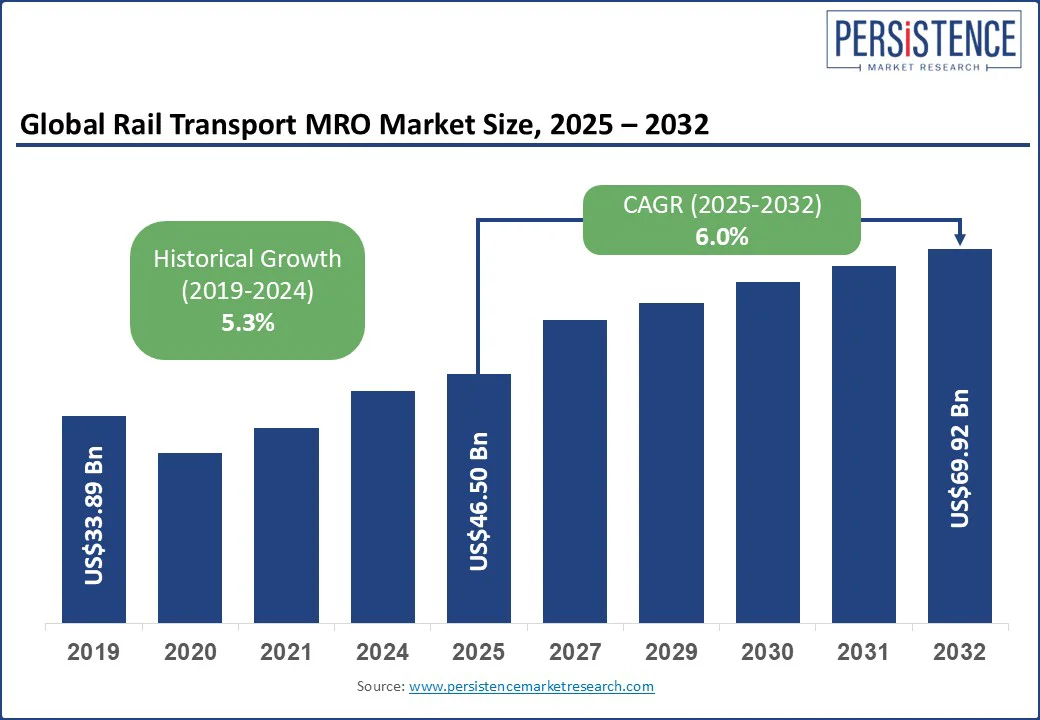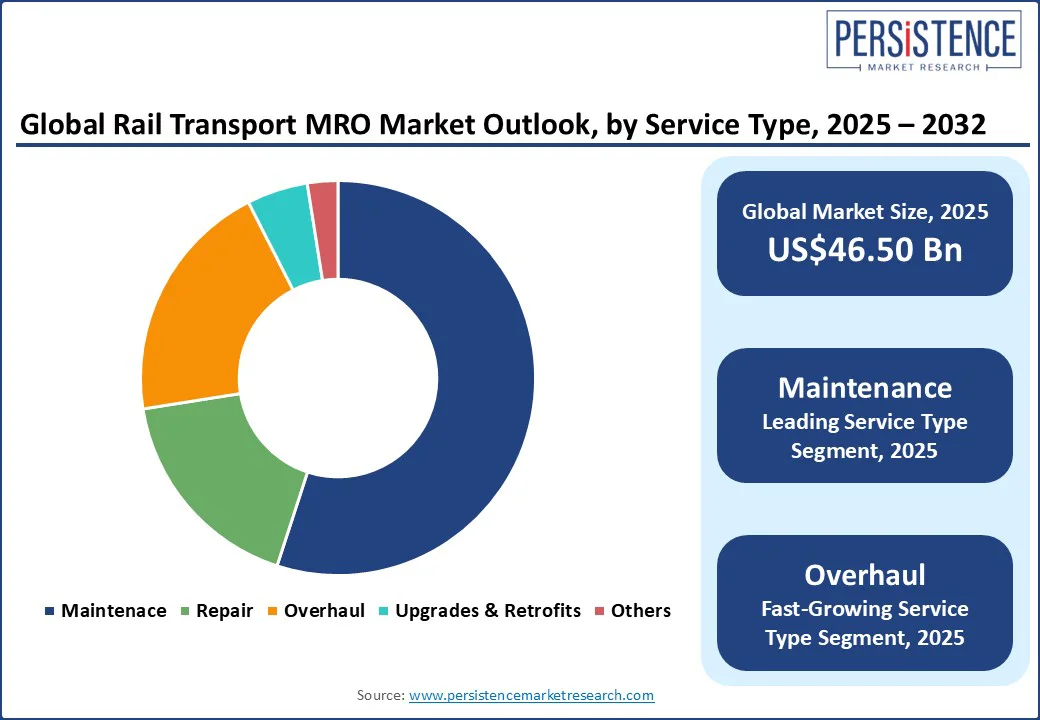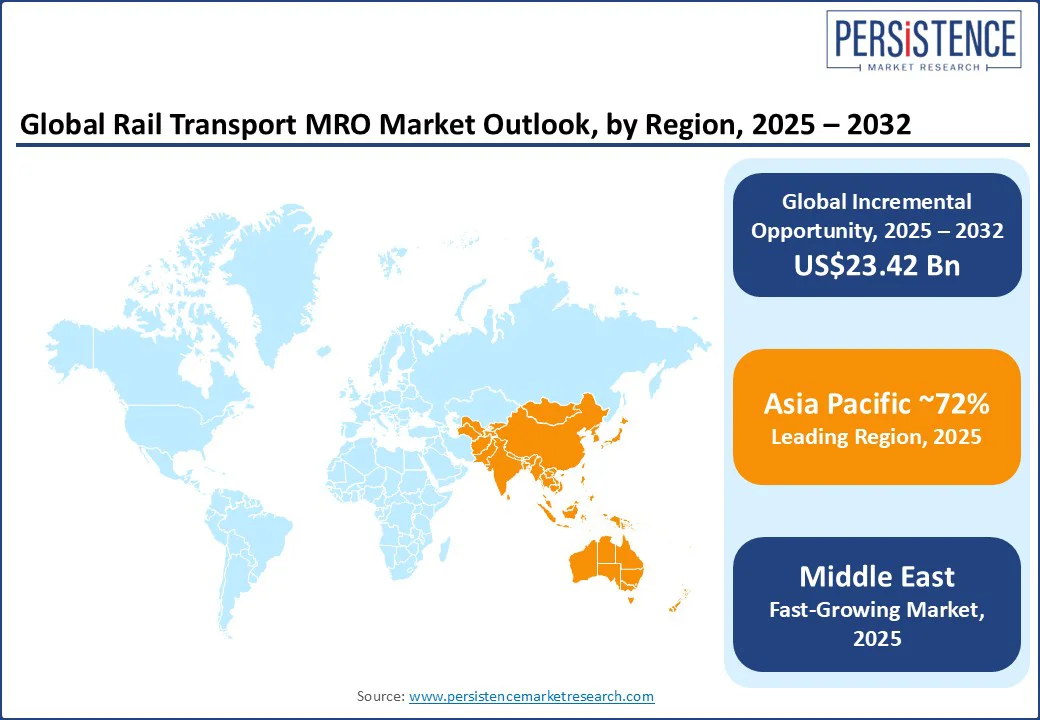ID: PMRREP35571| 184 Pages | 22 Aug 2025 | Format: PDF, Excel, PPT* | Automotive & Transportation

The global rail transport MRO market size is projected to rise from US$ 46.50 Bn in 2025 to US$ 69.92 Bn by 2032. It is anticipated to witness a CAGR of 6.0% during the forecast period from 2025 to 2032.
The proliferation of urban transit networks and the expansion of freight corridors across developing economies, along with the aggressive global electrification of locomotive fleets, are reshaping the growth trajectory of the rail transport MRO market.
Rail transport MRO (maintenance, repair, and overhaul) is the engine working behind the scenes across global rail operations, ensuring fleet uptime, safety, and profitability. The demand for MRO is propelled by electrification, digitalization, and rising infrastructure complexity. Electrified fleets are driving new needs in traction system overhauls.
In contrast, predictive maintenance powered by sensors, railway maintenance management system (RMMS) platforms, and AI has enabled more efficient condition-based servicing and performance-based contracts. Innovations in spare-parts logistics, including rotable pools and additive manufacturing, are minimizing downtime and inventory costs.
Key Industry Highlights

|
Global Market Attribute |
Key Insights |
|
Rail Transport MRO Market Size (2025E) |
US$46.50 Bn |
|
Market Value Forecast (2032F) |
US$69.92 Bn |
|
Projected Growth (CAGR 2025 to 2032) |
6.0% |
|
Historical Market Growth (CAGR 2019 to 2024) |
5.3% |
The most powerful force driving the rail transport MRO market is the accelerated digitalization of rail systems, underpinned by AI-powered predictive maintenance, IoT-enabled asset monitoring, and advanced edge-AI obstacle detection technologies.
While urbanization and stricter safety mandates are prompting governments to invest heavily in modernizing rail infrastructure and rolling stock, the deployment of AI-embedded vision systems capable of detecting track obstructions up to 2 km in advance is redefining maintenance strategies.
This is a visible shift from reactive repairs to predictive, outcome-driven service models. These edge-based solutions, combined with condition-based maintenance enabled by IoT sensors, significantly reduce downtime, optimize fleet availability, and improve safety standards.
Global initiatives such as the North American rollout of Positive Train Control (PTC) and the AI-managed rail operations under the Green Deal of the European Union (EU) are evidence of how rail transport is embracing sustainable mobility principles.
Fleet transitions from diesel to hybrid/electric propulsion, facilitated by innovations pioneered by market giants such as Siemens Mobility, Alstom, and CRRC, further highlight the fusion of technology adoption and sustainability imperatives. Apart from addressing operational reliability and regulatory compliance, the convergence of clean mobility and cutting-edge technology has also opened up lucrative opportunities for high-value MRO contracts, spare-parts optimization, and predictive service agreements.
The foremost constraints hindering market growth are supply chain disruptions and a shortage of skilled labor, both of which increase operational expenses and delay critical maintenance activities. Persistent bottlenecks in the global supply chain, including shortages and delivery delays of key raw materials such as steel and specialized components, have worsened inventory management issues and extended turnaround times, undermining maintenance efficiency and system reliability.
Even as the demand surges for modernizing urban rail systems, operators continue to grapple with inflated costs and prolonged lead times caused by such supply constraints, limiting fleet availability and compliance with safety standards. The industry also faces a shortage of qualified maintenance personnel, driven by retirements and insufficient training programs, which is hampering MRO capacity amid the global expansion of railway networks.
A key catalyst driving the growth of the rail transport MRO market is the definitive momentum generated by the adoption of advanced digital technologies, such as AI-powered predictive maintenance, IoT-based asset tracking, and data analytics. This, coupled with the accelerated regional rail network expansion, particularly in the Asia Pacific and the Middle East, is set to produce unprecedented market opportunities. These advancements enable condition-based servicing that cuts downtime and operational costs while boosting safety and compliance.
In the Asia Pacific, rapid urban rail growth in China and India, headed by government-backed high-speed rail projects, continues to drive the demand for scalable, tech-enabled MRO solutions.
For instance, between 2014 and 2024, India laid over 31,000 kilometers of new railway tracks and electrified nearly 45,000 route kilometers, reflecting the country’s rapid network expansion and commitment to sustainable rail infrastructure.
In the Middle East, large-scale initiatives such as Saudi Arabia’s Vision 2030 are spurring market growth by building local service capabilities and channeling state-led investments. By merging digital innovation with widespread fleet expansion across regions, the rail transport MRO sector is poised to capitalize on emerging opportunities, especially in passenger and freight services, setting the stage for sustained industry growth.
Within the service segment, maintenance is set to hold the largest revenue share of approximately 55% in 2025, fueled by its central role in safeguarding operational reliability and extending the service life of rail infrastructure and rolling stock. Urban transit expansion, such as the steady growth of metro networks in megacities such as Delhi, Toronto, and Paris, has escalated the frequency and complexity of upkeep cycles in the railway sector.
Meanwhile, regulators in the EU and the U.S. mandate periodic maintenance audits, pushing operators to adopt IoT-enabled condition monitoring systems and AI-based predictive analytics. For example, Deutsche Bahn’s use of AI algorithms to predict axle bearing wear has cut service interruptions by sizeable margins, illustrating how digital tools are reshaping maintenance regimes.
Overhaul services are projected to register the highest CAGR through 2032, reflecting a rising demand for full-scale refurbishment and modernization of aging fleets and infrastructure. Capital efficiency pressures, such as those faced by Indian Railways, are prompting operators to refurbish existing stock instead of procuring new units. Rail modernization programs have been kept active through strong government involvement.
For instance, China’s CRRC has executed multi-year overhauls incorporating energy-efficient traction motors, while Saudi Arabia’s network upgrades include digital train control retrofits to meet Vision 2030 goals. In Europe, the Green Deal has incentivized modernization over replacement to accelerate decarbonization without delaying service delivery.
The adoption of modular overhaul kits, the use of AI for overhaul scheduling, and MRO collaborations among original equipment manufacturers (OEMs) are making refurbishment faster, more cost-effective, and better aligned with long-term performance targets.
Among assets, infrastructure is anticipated to dominate in 2025 with a revenue share of nearly 60%, driven by massive spending to modernize and sustain rail networks by governments globally. Flagship undertakings such as Saudi Arabia’s Haramain High-Speed Rail and China’s Belt and Road Initiative are a testament to how mega-projects will create long-term MRO requirements.
Proliferation of metro networks, safety mandates that necessitate continuous upkeep, and the integration of technologies such as IoT-based track sensors for real-time condition monitoring and AI algorithms for predictive maintenance are ushering in a new growth phase for metro rail infrastructure MRO.
The movement toward digitized and sustainable asset management, through smart monitoring tools and modular maintenance approaches, only cements leadership of infrastructure in the asset segment for 2025 and beyond.
Rolling stock is forecast to post the fastest CAGR through 2032. Aggressive investments in fleet renewal, electrification, and targeted refurbishment initiatives are the main factors catapulting this segment. The surge in passenger and freight operations, particularly in the Asia Pacific and the Middle East, is fanning the demand for advanced servicing and upgrades to locomotives, freight wagons, and passenger coaches.
Technological innovations, ranging from energy-efficient traction systems to digital control modules and lightweight composites, are creating new avenues in the rolling stock MRO space. Notable examples in this context include CRRC’s AI-enabled diagnostics for locomotives and India’s retrofitting programs aimed at embedding green propulsion technologies. The adoption of modular overhauls and condition-based maintenance powered by big data is also gaining traction, enabling operators to extend asset lifespans and slash downtime.

Asia Pacific is likely to account for hold about 72.4% of the market share in 2025, owing to the heavy government-backed investments in rail expansion and modernization. For example, the annual budget for metro projects in India rose by an astonishing 500% between 2013-14 and 2025-26.
Rapid urbanization and industrial growth in China and India, headlined by flagship projects such as China’s Belt and Road Initiative and India’s National Rail Plan 2030, have sped up high-speed corridor construction, advanced signaling upgrades, and next-gen rolling stock deployment.
Railway operators in the region are also incorporating AI-based predictive maintenance, IoT asset monitoring, and energy-efficient propulsion to meet sustainability targets and improve uptime. CRRC exemplifies this innovation push through modular train designs and electrification upgrades.
With its vast passenger and freight networks, Asia Pacific stands out as the global epicenter where large-scale infrastructure projects and cutting-edge MRO technologies are converging at an unmatched pace.
The Middle East rail transport MRO market is projected to grow at the highest CAGR through 2032. Critical factors, including expansive government-backed infrastructure projects, regional connectivity initiatives such as Saudi Arabia's Vision 2030, and aggressive fleet expansions in both passenger and freight rail sectors, have made the Middle East the fastest-growing regional market.
Moreover, the market for rail transport MRO is accruing benefits from significant investments in smart rail infrastructure, digital technologies such as AI-driven predictive maintenance, and IoT-enabled asset monitoring, which collectively enhance operational reliability and reduce downtime.
Furthermore, evolving sustainability goals and the push toward electrification of rail fleets amplify investments in retrofit and modernization activities. The strategic geographic position of the Middle East as a transit hub also attracts global MRO service providers seeking to capture the upcoming opportunities in the region.
The growth of the market in North America is fueled by the long-standing freight dominance and mature rail infrastructure in the region. The demand for MRO services is unlikely to diminish any time soon in the region, considering the heavy dependence on freight rail for bulk commodity transport across the U.S. and Canada. Stringent safety and emissions regulations, and ongoing capital investments in asset renewal and digitalized maintenance practices have expanded the regional market scope.
The U.S. and Canada are accelerating the adoption of predictive analytics, remote diagnostics, and condition-based maintenance to minimize service disruptions and extend the asset lifespans, especially during network capacity upgrades.
Initiatives such as the full-scale implementation of Positive Train Control across U.S. Class I railroads have enhanced operational safety and data-driven oversight. Furthermore, collaborative programs such as Transport Canada’s Rail Safety Improvement Program have attracted public-private investment in technology-driven upkeep.

The global rail transport MRO market landscape is characterized by accelerated digitalization, targeted geographic expansions, and an unwavering commitment to sustainability imperatives.
Industry leaders such as Siemens Mobility and CRRC are pioneering scalable, modular MRO platforms and embedding AI-powered diagnostics into high-speed fleets, most notably in the Asia Pacific’s rapidly growing rail networks. Persistent challenges, including supply chain delays and skilled labor gaps, are driving OEMs, technology firms, and third-party providers to form integrated service ecosystems that share resources and expertise.
Green propulsion retrofits, such as hybrid and fully electric rolling stock modernization, are increasingly becoming core competitive strategies, aligned with policy frameworks such as Europe’s Green Deal and Saudi Arabia’s Vision 2030. The frontrunners in rail transport MRO, primarily CRRC, Siemens Mobility, Alstom, Hitachi Rail, Stadler, and Wabtec, are consolidating leadership by blending advanced analytics with sustainability-driven asset lifecycle management, securing a distinct advantage in an increasingly innovation-dependent marketplace.
The global rail transport MRO market is projected to reach US$ 46.50 Bn in 2025.
The proliferation of urban transit networks and the expansion of freight corridors across developing economies are driving the market.
The market is poised to witness a CAGR of 6.0% from 2025 to 2032.
The adoption of advanced digital technologies, such as AI-powered predictive maintenance, and the accelerated regional rail network expansion, particularly in Asia Pacific and the Middle East, are key market opportunities.
Alstom SA, Siemens Mobility GmbH, and CRRC Corporation Limited are some of the leading players.
|
Report Attribute |
Details |
|
Historical Data/Actuals |
2019 - 2024 |
|
Forecast Period |
2025 - 2032 |
|
Market Analysis |
Value: US$ Bn |
|
Geographical Coverage |
|
|
Segmental Coverage |
|
|
Competitive Analysis |
|
|
Report Highlights |
|
|
Customization and Pricing |
Available upon request |
By Service Type
By Asset
By Maintenance Type
By Component
By Region
Delivery Timelines
For more information on this report and its delivery timelines please get in touch with our sales team.
About Author